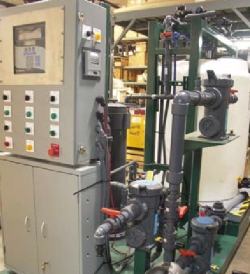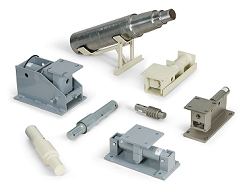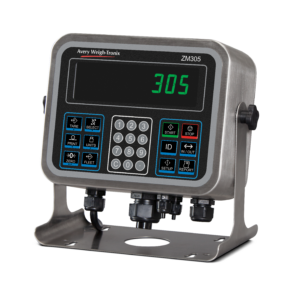Precision Weighing in Mixing and Blending Applications
Time is money; by using equipment and technology that can evolve with and anticipate operational needs, operators can enhance productivity. Integrating intelligent, sophisticated weighing technology with plant machines and equipment, manufacturers can achieve the precision required in dry processing operations. Particularly ingredient mixing in batching and blending applications.

Electronic scale systems, consisting of weight sensors and indicators, are designed to increase automation in dry processing applications. With advanced integration capabilities, automated electronic scale systems interface with plant devices and communicate with PLCs, PCs, and other vital operating systems to provide an automated weighing solution. System automation effectively decreases dependence on manual monitoring, manipulation, and operation, minimizing human error.
Benefits of automated batching and blending
While automating weighing processes provides manufacturers with greater control and visibility over the entire manufacturing enterprise, it also provides benefits beyond measurement accuracy. This technology has been applied to complex blending and batching applications. This allows users to experience improved quality control, increased inventory management, and reduced labor.
Quality control
Blending and batching applications rely on precision measurements, and often these products directly affect daily lives, such as food processing. Minute changes in measurements could have large impacts on product quality and customer satisfaction. Utilizing indicators with checkweighing features enables manufacturers to perform frequent quality checks. In so doing, this eliminates the need for a separate checkweigher and manual supervision. Simply enter upper and lower weight limits or use sample mode to configure. Indicators can be configured to perform standard deviation or deliver X Bar R statistical data. This ensures customers receive the correct value for their investment and manufacturers are not losing revenue from inaccurate measuring.
Inventory management
Using a scale system with advanced data logging and communication capabilities provides real-time product inventory updates. Indicators can track and monitor product usage or remaining amounts. They then communicate this information to office computers, signaling when product inventory is low and reordering is necessary. For example, indicators can be programmed to measure the weight of a tank after each time the product is dispensed. It will then repeatedly calculate the amount left. The indicator automatically totals product usage and eliminates risks of shortage and surplus concerns.
Reduced labor cost
By providing easy and effective integration with manufacturing equipment and communication devices, operators can minimize manual operation or interference. This allows the scale system to perform many functions that would often require an operator to complete. Thereby simultaneously increasing accuracy and reducing labor costs.
How do they work? Weight sensors in mixing and blending applications
A weight sensor, or load cell, is a steel structure with strain gauges, or electronic sensors attached. They are positioned on the outside surfaces—two sensors on the top and two on the bottom. As with most load cells, this structure acts as a cantilever, unsupported on one end and fixed on the other.

When a load is applied on the unsupported end, the sensors detect strain in the structure. They can then provide an analog mV/V output. This output is interpreted by indicator electronics, and the weight indicator digitally displays the strain as the load’s weight.
For dry processing, electronic weight sensors are placed under each leg of a material container. As weight is placed into a container, the electrical current running through each weight sensor is changed. This altered current is brought to and combined at a junction box.
From here, the collected data is sent via interface cable to a scale indicator. It can then convert the current to a digital weight display. Once affixed to a bin, tank, or hopper, weight sensors can transform these traditional containers into highly accurate, in-line scale solutions.
As an ingredient is dispensed into the container, it causes the suspended end of the weight sensor to deflect slightly as it absorbs the force of the load. The force measurement is then translated as the ingredient’s weight. As subsequent ingredients are added, the weight sensor deflects an appreciable amount from its current position. This will then represent the new ingredient’s weight.
The suspended end of the load cell then returns to its initial position once the container is emptied. Adding to this design, some weight sensors have two pairs of electronic sensors.
How do they work? Weight indicators in mixing and blending applications
Indicators are the brain of the weighing operation, collecting and communicating data throughout the manufacturing enterprise for process control that serves to improve accuracy as well as provide revenue optimization. For instance, data collected can be transferred via the indicator’s connectivity options, communicating information through intranet or Internet to allow operators to monitor and control operations from a PC anywhere in the world.

Indicators are also multitaskers, with some capable of simultaneously monitoring several independent scales as well as directly controlling automated weight-based operations. To facilitate at-a-glance decipherability, indicators employ a combination of text and graphics that clearly convey process status and product weights. This reduces read errors and allows operators to quickly take action if a process becomes obstructed or products do not meet weight regulations.
For instance, horizontal bar graphs can display over/under readings in checkweighing operations, vertical bar graphs display ingredient amounts, and pie graphs track rapid fill operations.
In dry processing applications, scale indicators can be programmed to control filling and batching applications through monitoring bins or hoppers. This is done by observing each operation until the designated container meets a user-programmed setpoint. This proves useful for ingredient mixing, as the indicator can be programmed to shut down each hopper after it releases its designated ingredient amount—ensuring the appropriate ingredient mix is achieved every time.
Weighing systems in action
For ingredient measurement in blending applications, using weight sensors and indicators together can automate these applications for improved accuracy and product consistency. Weight sensors are placed on each leg of the material container to capture readings. Coupling sensor technology with an indicator that stores recipe components ensures the exact amount of each ingredient is dispensed, without requiring operator intervention.
Once the measurement parameters have been entered into the indicator—usually consisting of weight ingredients and timed events—the automated weighing systems can be configured to recall recipes, automatically measuring according to the specified weight values or percentages. When the first ingredient is dispensed, the indicator monitors the weight sensor to identify when the first setpoint—the amount of the first ingredient required—is met. The indicator’s first output is then used to communicate this message to the dispensing equipment’s control system. The first ingredient valve is then closed, and the second ingredient is dispensed.
Further, these automated scale systems can accommodate rapid product switchover, controlling multiple weighing requirements in a single application while delivering high-quality results. For additional automation, indicators can be configured to track product usage, keeping a running total for inventory purposes—maximizing process efficiency and reducing inaccuracies due to operator error.
Indicators can also improve filling operations by preventing common measuring miscalculations, such as freefall error. As common sense dictates, though the indicator will send a stop signal to the dispensing equipment, there will likely still be material that is caught in mid-dispense mode. This causes the total amount of ingredient added to exceed the setpoint, a condition known as freefall error.
Conclusion
By utilizing innovative weighing technology to automate batching and filling applications, weighing inaccuracies and human error are minimized while uptime is maximized, allowing operators to realize their “time is money” philosophy with improved productivity and profitability.

 United Kingdom
United Kingdom  Canada
Canada  Canada (fr)
Canada (fr)  India
India  Malaysia
Malaysia  Ireland
Ireland